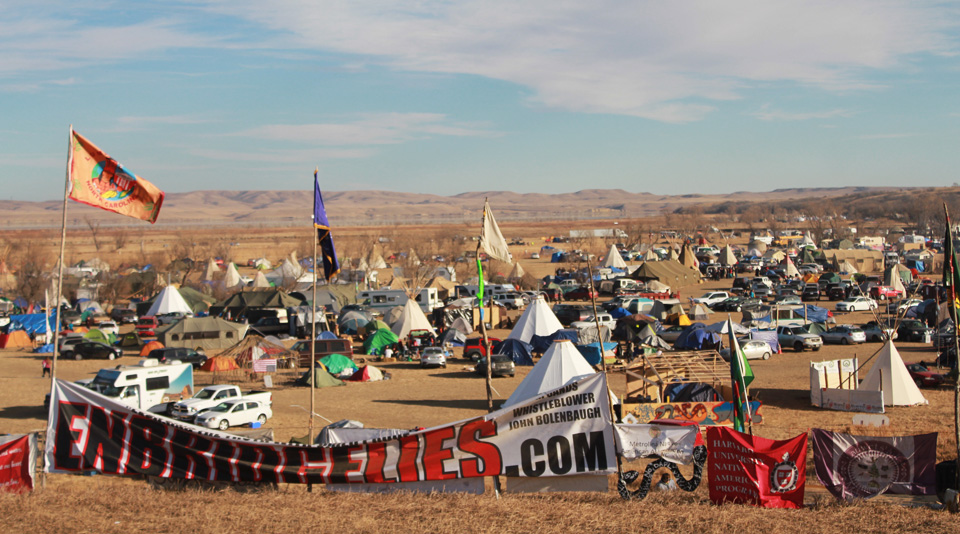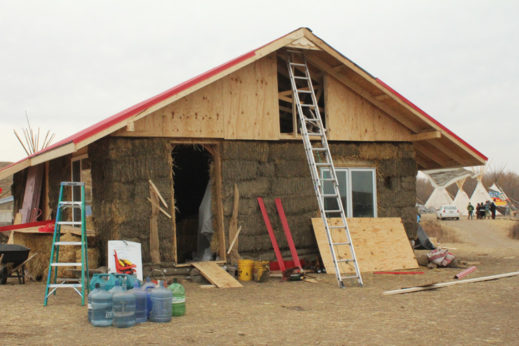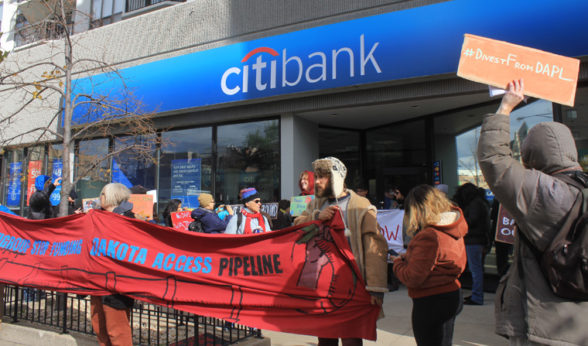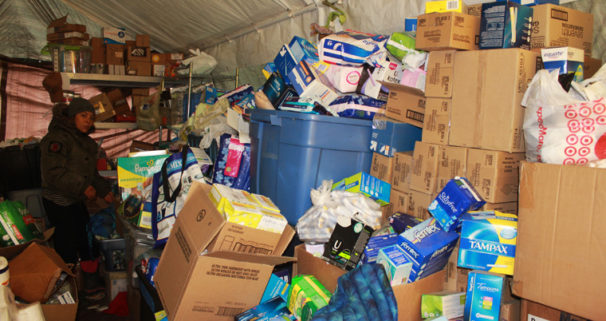
CANNON BALL, N.D., Nov. 25 — Visitors driving up to “Flag Road” (the nickname for the entrance to the Water Protectors’ sprawling encampment near the Dakota Access pipeline construction site) are greeted by volunteer security personnel. Camouflage-clad Water Protectors (as the pipeline protesters call themselves) are stationed 24 hours a day at the security post near the entrance gates. They inspect approaching vehicles filled with donations and incoming supplies, and help guide newcomers to the proper camping grounds. The rules of the site are painted on large signs for all visitors making their way into the Oceti Sakowin camp: No drugs. No alcohol. No weapons. Upon crossing the checkpoint and hearing of our return, the guard gave People’s World reporters a reassuring nod. “Welcome home.”
Standing Rock is, indeed, now “home” to an estimated 4000 Native individuals and allies. What once started as an act of defiance against the $3.8 billion pipeline infrastructure is now both an independently operating community and a template for strategic organizing across the nation. The occupation continues to expand daily, with numbers quickly rising as the fight against the Dakota Access Pipeline grows increasingly popular as a topic among mainstream news outlets.
The campgrounds are scattered throughout a number of separate locations, including Oceti Sakowin, Red Warrior, Sacred Stone, and Heyoka. Each of these individual sections are unofficially acknowledged by the Water Protectors as serving a distinct function within the camp’s overall ecosystem. Some areas are designated for those involved in direct action and providing supply lines and support to the front line of resistance where the Water Protectors confront police and hired security agents. Others are considered sanctuaries that primarily shelter elders, women, and children.
Movements for social change have in recent decades built similar models of organized dissent, with movements such as Black Lives Matter, Occupy Wall Street, and the Fight for 15 picking up steam in recent years. Yet the cause of environmental justice for the Standing Rock and Cheyenne River Sioux tribes appears to have reached a tipping point among progressives who recognize the threat to water as part of the capitalist exploitation of marginalized and working class people. Few movements have been able to mobilize such a diverse range of organizations and groups under a unified cause in the way that ‘No DAPL’ has.
Activists say the battle against the Dakota Access Pipeline is a human rights issue, an environmental issue, and a battle against militarized police forces. Above all, they say, it is a demand to reclaim stolen land, and an outcry against a government that promised to do right by the citizens of this nation.

The Standing Rock occupation has developed immensely over the course of the last several months, not only in numbers, but through the expanding infrastructure of a rapidly developing community. Leo “Gunner” Baker, a Water Protector from Minnesota, and a leading voice at the Oceti Sakowin camp, told People’s World that the movement started off with only a handful of people setting up a tipi in an open field. “Now to look around and to see thousands, I mean absolutely thousands of people out here – camp as far as the eyes can see in all directions – it’s getting to the point where it’s really becoming like a city in and of itself.” Baker said that the expansion has been accompanied with its own set of problems: parking issues, zoning regulation, winterization, and lack of access to resources are all points of concern that the community must address.
Additionally, recent run-ins with militarized police forces, have brought the public’s attention to the site, as live streaming and social media platforms exposed the unnecessarily brutal methods being used against the unarmed water protectors. This has resulted in an influx of visiting activists, eager to assemble, and has led the Standing Rock community to establish a set methodology for direct action training at the Oceti Sakowin camp.
Lauren Small Rodriguez, a volunteer medic from the Northern Cheyenne tribe in Montana, and military veteran with a background as an emergency medical technician, has been traveling back and forth to Standing Rock for several months. “A woman was almost killed here- her name was Sophia [Wilansky] from New York – my fellow comrade was the first responder on the scene to get her out of harm’s way.” Rodriguez has noted that tension between opposing sides have increased, as she has witnessed people bringing supplies to the camp getting pulled over without probable cause, “It’s like the Wild West, when you come here, you are at risk of getting stopped, getting harassed, being interrogated for no reason, and it’s not right.”

While one of the tactics that makes the #NoDAPL cause so effective is its unique strategy of advocating through direct action and peaceful assembly, a lesser-known facet of the movement is that it also demands economic divestment. The Water Protectors have also begun striking back at several of the 17 banks that are directly funding the pipeline project. There is an ongoing campaign called #DefundDAPL, that encourages the public to move their money from away from the banks and other companies that have sponsored the Dakota Access Pipeline. So far, activists estimate they have been able to persuade the public to divest over $3 million. “I closed my checking and savings account with Chase Bank,” said Chicago resident and #NoDAPL organizer Samantha Garcia. “I refuse to sponsor first amendment rights violations of American citizens along with the continued oppression of Indigenous people on this land.” The divestment crusade among shareholders has also begun to take effect, as the environmental group EcoWatch reported last week that Odin Fund Management, one of Norway’s leading fund managers, announced it had sold $23.8 million (243 million NOK) worth of shares invested in the companies behind the Dakota Access Pipeline.

The #DefundDAPL campaign continues to work to offer comprehensive banking alternatives, as the water protectors continue their work back in North Dakota. Activists hope that they will be able to hold their ground until the rumored January deadline when the contract for the pipeline ‘expires.’ According to the fact-checking website Snopes, however, the claim is only partially true. “Dakota Access Vice President Joey Mahmoud said in an August 2016 court filing that if 1 January 2017 came and went without progress, third parties would be able to cancel business contracts related to the pipeline,” writes Snopes. However, neither opponents nor proponents of the pipeline have asserted that if it isn’t completed by January 1 that it cannot be completed at all.
Regardless of what happens by the January 1st “deadline”, Water Protectors say they intend to continue their battle against the oil giant conglomerate including Energy Transfer Partners, the main company backing the pipeline. With little to no help from the Obama administration, the community has rallied together in time for winter. Yurts and tipis are now being furnished with stoves and insulated for the cold. Volunteers also remain busy erecting new mobile shelters, including a new school structure for the children. While many individual water protectors come and go, the movement has remained strong and united. “Nobody is leaving,” said Rodriguez, glancing out across the field of tents and tipis. “We’re here to stay.”









